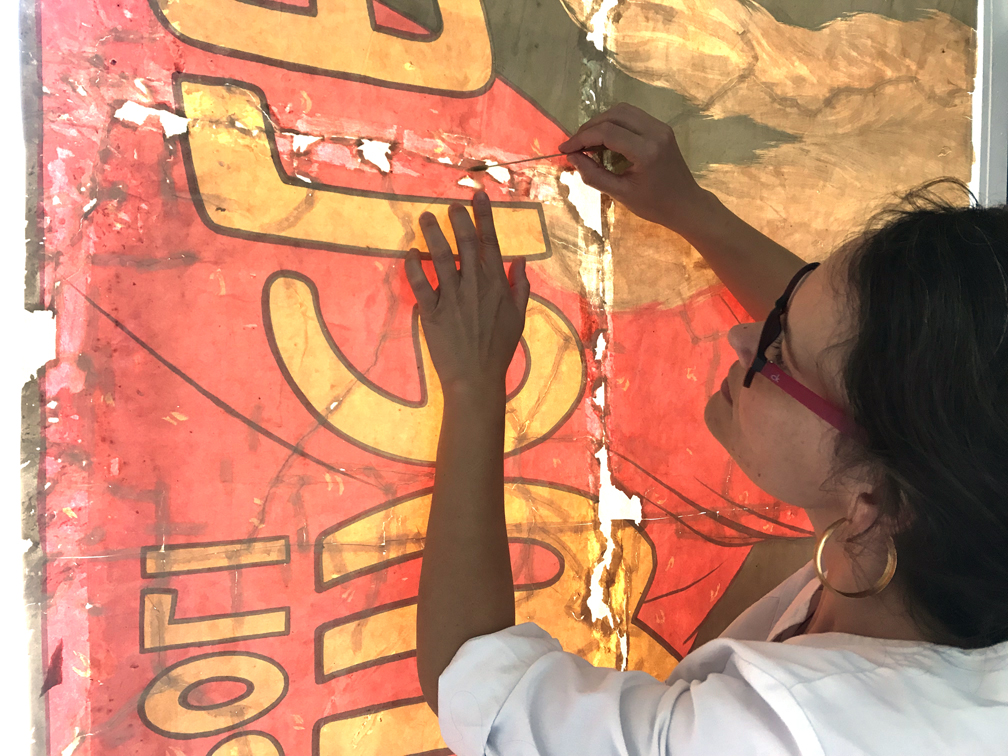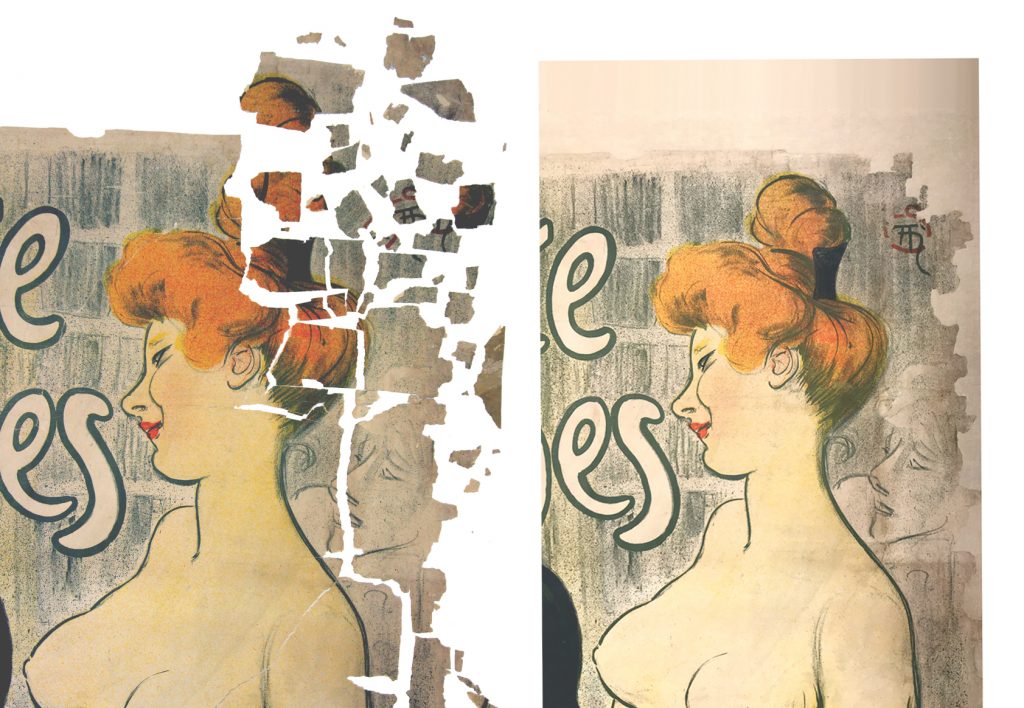Berta Blasi
We have on the operating table before us 14 large-format patients.
They are 13 posters by makers who have left their mark on Modernisme: Adolf Hohenstein, Jean Ubaghs, Théopile Alexandre Steinlen, Jules Chéret, Ethel Reed, Henri Privat-Livemont, Leonetto Cappiello, Henri-Gustave Jossot and Leonardo Bistolfi, and an original drawing by Apel·les Mestres, recently identified by Mercè Saura and Francesc Quílez.

Front of poster E. & A. Mele & Ci by Leonetto Cappiello before, during and after restoration. Photographer: Berta Blasi.
They are all part of the collection of the Museu Nacional d’Art de Catalunya’s Cabinet of Drawings and Prints and they have been chosen for the exhibition Posters of Modern Life, organized by the Fundació ”la Caixa”, which will display them around the country.

Pre-consolidation from the front with remoistenable Japanese paper of poster E. & A. Mele & Ci by Leonetto Cappiello. This process guarantees that, during the process of consolidation from the back, the poster drawing fits perfectly. Photographer: Berta Blasi.
After being inspected by the expert eyes of the museum’s Department of Conservation-Restoration and Preventive Conservation, the verdict is delivered: the posters cannot be displayed without prior restoration work to guarantee their preservation. Therefore, some of the posters are restored in the museum and the restoration of the others is outsourced to restoration workshops that under the direction of the museum, which establishes the criteria for the work (which materials to use and what techniques to apply, or to what extent it is necessary to clean, restore losses of support or of colour, etc.), work together with the museum like a well-oiled machine.
And so, fourteen large-format patients arrive on the operating table.

Consolidation under transmitted light of the tears and the losses of support from the back of poster E. & A. Mele & Ci by Leonetto Cappiello. Transmitted light allows us to see small tears and losses of support that had gone unnoticed in the previous consolidation. It is an absolutely necessary step when the flattening is done under tension since these small weak points could cause large tears during the drying and tautening process. Photographer: Berta Blasi.
They are thirteen posters printed on paper that present the typical kinds of deterioration of large-format works: folds, tears, loss of support, creases … the majority of them were repaired or restored many years ago.

From left to right, Berta Blasi and Raquel García stick the strips of Japanese paper to the edge of the poster, which will make it possible to flatten poster E. & A. Mele & Ci by Leonetto Cappiello under tension. Photographer: Berta Blasi
Restorers usually saythat one of the worst situations we can find ourselves in is when a work has been previously restored. Everything is complicated when a work has been handled a lot because the strict criteria that now govern us have not always been applied.

Mechanical dry cleaning of the posters to eliminate surface dirt. In this case it is the cleaning of a tear with a hard rubber. Photographer: Berta Blasi.
At first sight, we divide the 13 posters into two groups: those that are reinforced on the back with Kraft paper adhesive tape and those that are covered with cloth on the back. We imagine the work done, possibly in a rush, with the intention of saving as much heritage as possible in the shortest amount of time available. Objective achieved: we now have them here on the operating table; otherwise they might have never arrived.

Colour correction of a loss of support restored on poster La traîte des blanches by Théophile Alexandre Steinlen. With colour correction the losses of support are successfully restored with an optical effect: the viewer’s eye does not detect that the drawing is missing in that place. Photographer: Berta Blasi.
But it is when we roll up the sleeves of our heritage doctors’ white coats, when we treat each individual patient, that we realize every one of them is suffering from something: most of the fabric covering can be removed easily but suddenly there is one piece that refuses to be removed from the back of the poster. The adhesive tapes that have been on the paper for so long are hard to remove, but, at the same time, there are some that go just by looking at them. All the seals are insoluble except for one rebellious one, which decides to play a practical joke…

Elimination of the fabric covering from the back of poster Ars by Adolf Hohenstein with moisture treatment. Photographer: Berta Blasi
And it is then when we go “all in” and show our cards. We bet big on everything we have learned over the years in the profession and our continuous training, and we stake everything on it. And this acquired knowledge rewards us with truly spectacular results. Judge for yourselves.

Detail of poster La traîte des blanches by Théophile Alexandre Steinlen in which the work done in the restoration workshop can be seen. The fragments have been matched and consolidated, the losses of support or areas where the paper was missing have been restored, and finally their colour has been corrected. Photographer: Berta Blasi

Flattening under tension is a process that requires a high degree of technical expertise; many factors have to be controlled, and experience, as always, is a degree. Here the poster can be seen with the strips of Japanese paper that have just been stuck to the panel (left) and the poster once it is dry and tight (right). It can be observed that the undulations have completely disappeared. Poster La traîte des blanches by Théophile Alexandre Steinlen. Photographer: Berta Blasi

Poster Première Exposition Internationale des Arts Décoratifs Modernes by Leonardo Bistolfi, front with grazing light, back with Kraft paper adhesive tapes and front after restoration. Photographer: Berta Blasi

Colour correction of a loss of support restored on poster La traîte des blanches by Théophile Alexandre Steinlen. With colour correction the losses of support are successfully restored with an optical effect: the viewer’s eye does not detect that the drawing is missing in that place. Photographer: Berta Blasi
Berta Blasi and Raquel García withdraw the previous interventions, which in this case is a cloud on the back of the poster La traîte des blanches taking advantage of the process of wet cleaning by capillarity.
After removing the previous repairs, the posters are fragmented into a thousand pieces that are gradually pre-consolidated temporarily by the obverse to ensure that the drawing fits perfectly. Then the tears on the reverse will be consolidated and the pre-consolidation of the obverse will be removed. Poster E. & A. Mele & Ci.
Finally, in order to harmonize the poster aesthetically and to be able to contemplate it in all its splendor, a chromatic reintegration is carried out, that is to say, the great losses of support are colored in order to be able to visually enjoy the set of piece E. & A. Mele & Ci.
Berta Blasi
Restorer @taller_BBlasi
Related links
Sessió en línia sobre la conservació i restauració del patrimoni documental







